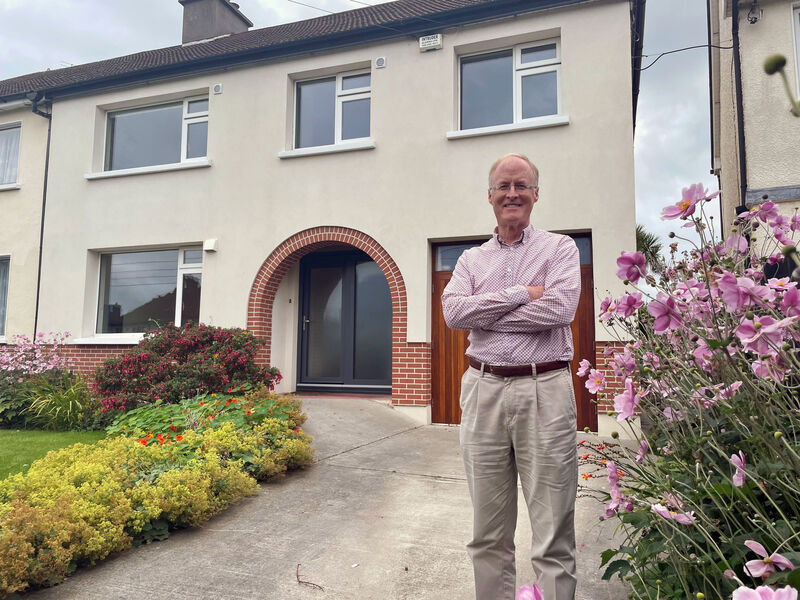Home retrofitting: Costs, grants available and work involved

Cormac Madden outside his retrofitted home in County Dublin.
Here are just some of what you can enjoy with a little help from our friends at the Sustainable Energy Authority with individual grant or fuller, holistic one-stop-shop grant awards.
Low
High
Improved
Dependent on attic/roof size, chosen materials and scope of the work. An intelligent low spend for a very high return in terms of warming up the envelope of the home
A whopping 80% of the ticket through the One-Stop-Shop grant aid for deep (comprehensive) retrofit, and through individual grants. It is graded on home type.
CLIMATE & SUSTAINABILITY HUB
For individual insulation grants to the attic, it’s up to you to apply and manage this grant, which will be paid back to you on completion of the work and the carrying out of an obligatory BER survey which will be published becoming part of your home’s energy profile (once-off BER grant of €50). First find your supplier. Ensure they are on the SEAI Registered Contractors List. Your supplier/installer can often help with the application. With the One-Stop-Shop mechanism your project manager will assign a contractor. The installation must reach the SEAI required U-values of 0.16 W/m2 K for ceiling level insulation or 0.20 W/m2 K for rafter insulation.
Minimal but with the thumping around in the attic and a lively team indoors, you might want to clear off for a few hours. Likely to take half a day to a full day to complete with the insulation of pipework, covering of hatches and improvement to the existing blanket. In a deep-retrofit, the impact of the simultaneous renovations is likely to have driven you out of the house already. Insulating pitched ceilings from the plasterboard side can be invasive, expensive, and a headache on par with internal dry lining.

Significant capital outlay
Steady but slow
Reduced; battery grant removed
Balanced against the slow 8-10 year payback period, photovoltaic panels have a high capital outlay in the area of €80000-€12000 after grant aid, for a 3.2kWp-5kWp array inc VAT, married to suitably sized storage battery and hot water diverter. Consider a green-loan mechanism with monthly payments and a low-interest rate from your credit union or bank. Solar Thermal offers a less costly alternative if you are simply after free hot water; €1200 grant aid.
Total grant aid is graded by kWp (the battery grant has gone). €900 per kWp for the first 2kWp, 300 for every additional kWp, capped at €2,400 for 4kWp. The independent grant is retroactive, so your supplier must be paid in full. With all the required receipts and certification required of your supplier (evidence of works) filed, you then recover the SEAI grant award directly to your bank — this can take up to eight weeks after install.
The full on the ground survey that forms part of your PV project is a vital moment. Without a deep-retrofit, project manager, there is no SEAI led technical assessment, so you are relying on the skill of your supplier to design and detail your system. In most cases, if the aspect is willing, a standard domestic roof can take PV and a flat roof can support frames. You should have an idea of your monthly electricity use to guide a PV technical survey. Think about where you would like the inverter and any battery to be sited indoors.
Planning permission is currently required if you have more than 12sq m of panels or take up more than 50% of the area of the entire roof — whichever figure is smaller. A bill is progressing through The Oireachtas to squash permission for domestic arrays. Surprisingly low hassle, with many installations complete in one day. Expect exterior scaffolding towers, workers in your attic space and some minimal household invasion. The power will of course be off for extended periods, so if you’re working from home, choose a nearby digital spot and rattle out your work there. Get a full lesson in every aspect of your system and monitoring software, to become truly reactive — the early days can be stress soaked as you monitor the gain feverishly.
Small
High
Unchanged
Highly dependent on the branding and system you choose, but you’re unlikely to get much change from €1,500-€2,000 for a home without the basics of two zones with heating and domestic hot water control. Ultimately you need the basics that will improve your comfort levels and increase the energy efficiency of your existing heating system. The speed of payback in a time of soaring energy costs is potentially excellent for the spend with new, economical habits.
The SEAI suggests you ask yourself the following: Can you heat your domestic hot water without switching on your radiators or an electric immersion heater? Can you turn on your heating without heating your domestic hot water?
Low, once you are assured with a detailed quotation covering associated costs.

Low, vital for BEV adopters and PHEV drivers
Reliant on complexity; €1000-€1500 before grant aid. Prices can go way up if you fancy some facial recognition technology, touch screens and elaborate Wi-fi smarts
Decide on a position for your charger and supply a few images to your chosen installer. These will generally show the charger position, an image of the fuse box on the wall in your home showing where it is in relation to the outside wall, and a description and approximate distance of its position in relation to your charger position. Your supplier will talk you through the complexities of Type 1 and two tethered connectors, whether you require a 5m or 10m cables.
Minimal, with installation from as little as two hours following an on-site survey. A virtual survey will smooth and accelerate the experience. ESB Meter Box connection is possible in some cases, and your charger may be attached to a dedicated post. Extras take more time.
Moderate
High
Improved
From €700 to over €2,000 depending on volume of product and labour, for pumped foam or polystyrene beads injected into the wall along with a bonding agent to stabilise them. The cavity must be to NSAI standards and specifications. The wall must reach a target U-value of 0.27 W/ m2 K to qualify for the grant
If you don’t have any certification, check if you have cavity fill or not. The area around the cable or meter boxes attached to the outside of the house may show signs of the former install. Filling the cavity will not cure damp, but it can regulate it. It will have no influence on rising damp, which should be addressed independently.
Small holes around 23 millimetres in size must be drilled in the mortar joints of your walls, but at 1.5m spacings, these are easily disguised.

Cormac Madden contracted Electric Ireland Superhomes to manage his heat pump installation and solar PV at his County Dublin home.















